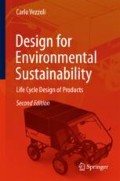Abstract
Extending the lifespan of materials means making them last longer than the products they are part of. This kind of reincarnation of materials can take place through two fundamental processes
Access this chapter
Tax calculation will be finalised at checkout
Purchases are for personal use only
Notes
- 1.
About this, cf. Box 9.1.
- 2.
Smoke containing chlorine and bromine is the most aggressive. Dioxins emanate from the combinations of these and other organic residuals.
- 3.
From this waste nothing but few metals can be recovered.
- 4.
For different options for separating materials, cf. Chap. 10 of this Part.
- 5.
In the case of plastics that are cleaned before identification and separation.
- 6.
For example, the labels and adhesives stuck on the products.
- 7.
These kinds of cost are especially present when dealing with the collection of materials that are going to be incinerated, composted or sent to landfill.
- 8.
In Chap. 10 of this part.
- 9.
When speaking of post-consumer extensions.
- 10.
For this topic, cf. Chap. 10 of this part.
- 11.
Materials with high market values after recycling are, for example, chrome, nickel, aluminium, steel, ABS, ASA, PA, PC, PMMA, POM and the thermoplastic elastomers.
- 12.
A careful impact analysis (as we are going to see in Chap. 13, Part III, the Life Cycle Assessment is one of the most secure methodologies) can identify the most feasible hypothesis.
- 13.
Cf. Box 9.1.
- 14.
Such as public entities or contractors, who deal with the end-of-life collection of certain products and materials.
- 15.
For example, in UN 11469 standards.
- 16.
Cf. also Box 9.1.
- 17.
For example, plastic materials, because they are easily moulded and very plastic, allow to the parts that otherwise would have to remain separated to be integrated into one component.
- 18.
For further details, cf. Chap. 10 of this Part.
- 19.
Organic compound additives, for example, are rarely recyclable.
- 20.
For example, hospital waste.
Author information
Authors and Affiliations
Corresponding author
Rights and permissions
Copyright information
© 2018 Springer-Verlag London Ltd., part of Springer Nature
About this chapter
Cite this chapter
Vezzoli, C. (2018). Extending the Lifespan of Materials. In: Design for Environmental Sustainability. Springer, London. https://doi.org/10.1007/978-1-4471-7364-9_9
Download citation
DOI: https://doi.org/10.1007/978-1-4471-7364-9_9
Published:
Publisher Name: Springer, London
Print ISBN: 978-1-4471-7363-2
Online ISBN: 978-1-4471-7364-9
eBook Packages: EngineeringEngineering (R0)

